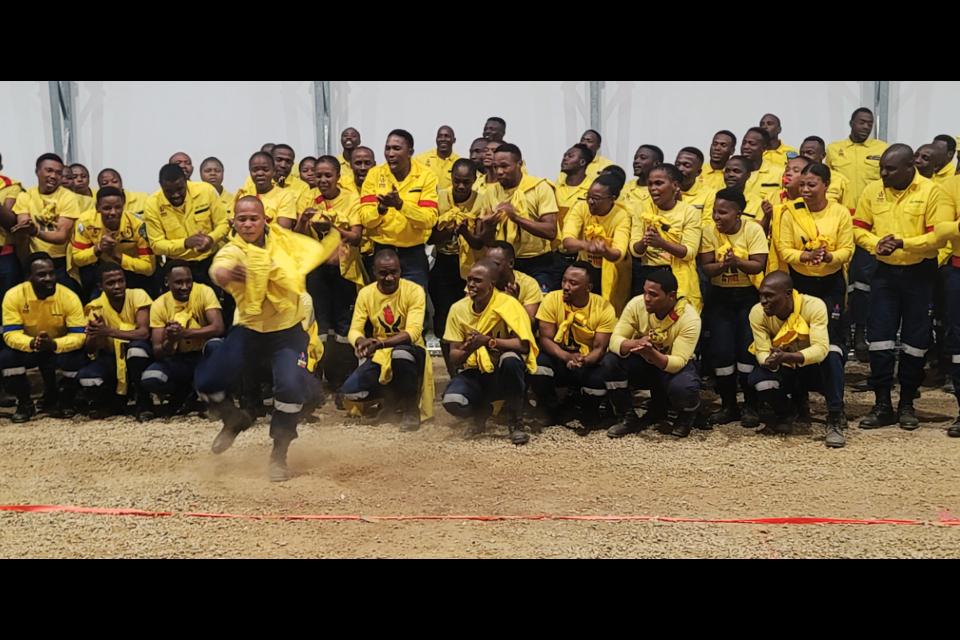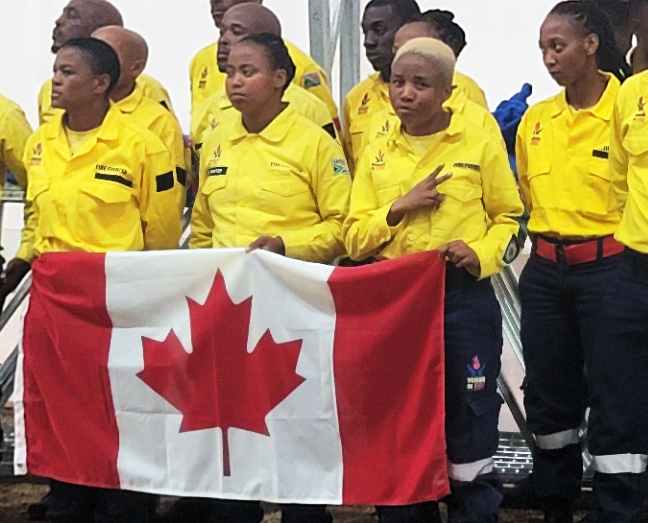After a month battling B.C. wildfires, a group of 215 South African firefighters is going home this weekend, just in time for the Heritage Day holiday Sunday in their homeland.
On their last night in Prince George, they showed the spirit that binds them in a soulful presentation (video) of traditional song, chants and dances (video) to wrap up their Canadian tour of duty.
The 60 women and 155 men were selected from disadvantaged cities and towns to form a national firefighting force sent to help fire-ravaged Canada.
For Thursday’s evening sendoff ceremony (video), they formed groups that represented seven of the nine South African provinces to provide a memorable night of entertainment (video) for officials from BC Wildfire’s Prince George Fire Centre and an American firefighting unit united in the efforts to suppress fires burning west of the city.
“It has been a great pleasure to give support to our brothers and sisters in this part of the world, it was a very good experience,” said Antoinette Jini, senior representative of the South African force.
“The incident management team opened their hearts and has lovingly taken us through the whole incident and have given us support and briefed us on the objectives of the assignment and I think we did exceptionally well.”
Incident commander Steven Goldman of the U.S. Forest Service praised the work of the South African firefighters to suppress hot spots as as part of 600-firefighter force in the Vanderhoof-Fort St. James fire zone, They performed that dangerous work incident-free and without injury.
“We are proud as South Africans that we came and made an impact in Canada,” said Jini.
“The most important thing is we are team players and this is what we think we’ve achieved. We became part of a team with one vision. We’ve built the relationship among Canadians and our role was to build the partnership and stakeholder relationship and make a difference and I think through our music and dancing, people were touched.”
They brought that same enthusiasm and unity working 12-hour days on the fire line. From the moment they stirred from their tents to line up for breakfast it was a regular occurrence for them to break into song and dance before they loaded into trucks to bring them to the fires near Vanderhoof, Fort St. James, Kamloops and Kelowna.
The South African force spent several weeks in Alberta fighting fires on mop-up/clean-up detail and hot-spot patrols before they arrived in Kamloops Aug. 29. They made up one third of the Van-Jam firefighting force and had the numbers to make up 11 unit crews.
All of the 215 South Africans speak English and their selection was based on each of them meeting Canadian fitness standards, which was highly evident watching them perform their athletic dances. The South African government employs them and it is their full-time occupation. Jini said some of them use their training as firefighters as a springboard to become police officers or paramedics.
“All of them are taken from disadvantaged communities, it’s a poverty-relief program we provide for those who are jobless or didn’t finish school, as long as you can read and write,” said Jini. “The program started in 2004 and we’ve got alumnis who have gotten to better places in life because of this program.”
South African unit leader Khulani Zulu lives in Pietermaritzburg, capital of the KuaZulu-Natal province, and his trip to Prince George was his fourth firefighting mission in Canada. He arrived in Prince George Sept. 12 and in that two weeks he gained much from watching the BC Wildfire Service and U.S. Forest Service crews in action.
“There are things happening in Canada which we do not have in South Africa, so it was a great experience,” Zulu said.’ The incident command system that is being used here is very amazing. You see many structures pulling together in one incident to make sure they achieve the goal to put the fire out.”
Zulu also learned about ash pits, holes left by the burning of organic matter and roots that collect hot embers below ground level. The pits can remain hot for days after a fire has been extinguished and if undetected can cause serious injuries or death if someone falls into one.
“We don’t have ash pits in South Africa but here we encountered that,” he said. “The terrain isn’t much different, it’s only the trees. The spruce trees here , when it’s windy they just fall. In South Africa the roots are better and the trees are more stable in the soil.
“That’s one of the most dangerous parts of firefighting and you have to look up to ensure that no one is getting tripped or that the trees are falling into them. We appoint a lookout who works behind the team who can tell them when there is a tree that might fall down.”
During the two weeks they camped in Prince George there was downtime on the fire line while crews waited for work assignments and the South Africans took advantage of that to work out their dance moves and flex their vocal cords.
“They get free time to dance,” Zulu said. “It’s the type of music that brings their morale up. The moment that start singing, it motivates them to keep going on the fire line.
“It’s so refreshing. Once you start a day with the melody of their voices in your ears that helps you keep going and keeps you motivated to do more. You need that to revamp your spirit.”
The 2023 fire season, which started in early May, has burned an unprecedented 2.5 million hectares of B.C. forests and the province has leaned on the support of about 1,000 out-of-province and international firefighters from South Africa, the U.S., Mexico, Brazil, Colombia and France.
Of B.C.’s total, 1.92 million ha has burned in the Prince George Fire Centre, which encompasses most of northeastern quadrant of the province. As of Thursday there were still 130 fires in that area, 66 of which are out of control, with five wildfires of note in the region.
“It’s not normal for us to have this amount of fire on the landscape at this time of year,” said Sharon Nickel, community engagement specialist for the BC Wildfire Service. “Unfortunately we’re in worse drought conditions than we were last year at this time and we have exponentially more fire on the landscape. Back in July in the Prince George Fire Centre we surpassed our 20-year combined total hectares burned.”





